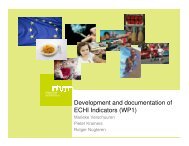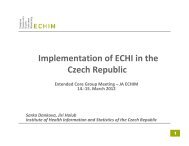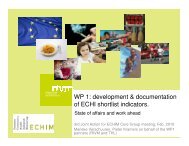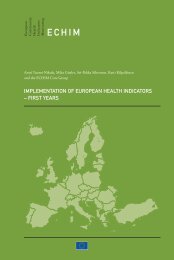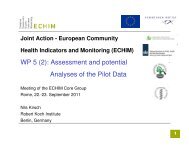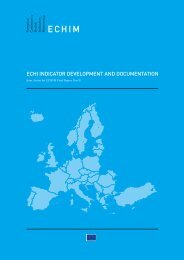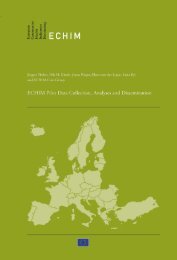INDICATORS
ECHIM Final Report
ECHIM Final Report
Create successful ePaper yourself
Turn your PDF publications into a flip-book with our unique Google optimized e-Paper software.
74. MEDICINE USE, SELECTED GROUPS<br />
Definition:<br />
1) Percent of population who have used medication (defined medicine groups) prescribed by<br />
a physician during the past 2 weeks.<br />
2) Amount of medicine use, per day per 1000 population, for defined medicine groups.<br />
Calculation:<br />
1) Percent of population who have used medication (defined medicine groups) prescribed<br />
by a physician during the past 2 weeks, measured by the EHIS instrument derived from<br />
EHIS questions MD.1–2. MD.1: during the past two weeks, have you used any medicines<br />
(including dietary supplements such as herbal medicines or vitamins) that were prescribed or<br />
recommended for you by a doctor – (for women, please also state: include also contraceptive<br />
pills or other hormones)? (yes / no). MD.2: Were they medicines for…? (15 medicine<br />
groups, i.e. for Asthma / Chronic bronchitis, chronic pulmonary disease, emphysema / High<br />
blood pressure / Lowering the blood cholesterol level / Other cardiovascular disease, such as<br />
stroke and heart attack / pain in the joints (arthrosis, arthritis) / Pain in the neck or back /<br />
Migraine / Other pain / Diabetes / Allergic symptoms (eczema, rhinitis, hay fever) / Stomach<br />
troubles / Cancer (chemotherapy) / Depression / Tension or anxiety) . Precise medicine<br />
groups to be included are to be decided later.<br />
2) OECD / EURO-MED-STAT -project: OECD / EURO-MED-STAT -project:<br />
Pharmaceutical consumption per 1000 population, in Daily Defined Doses (DDDs) per<br />
day, by selected Anatomic Therapeutic Chemical (ATC) groups. Calculation is based on the<br />
volume of sales to pharmacies and hospitals by wholesalers. DDD is defined as the assumed<br />
average maintenance dose per day for a drug used on its main indication in adults. The<br />
MINDFUL project specifically recommends to include antipsychotics (ATC class NO5A),<br />
anxiolytics (NO5B), hypnotics (NO5C) and antidepressants (NO6A). Precise ATC medicine<br />
groups to be included are to be decided later.<br />
Notes: The ATC system divides drugs into different groups according to the organ system on<br />
which they act and/or therapeutical, pharmacological and chemical characteristics. (created<br />
by the WHO Collaborating Centre for Drug Statistics Methodology). The sale and actual<br />
use of drugs are not always the same figure.<br />
75. PATIENT MOBILITY<br />
Definition: The number and proportion of patients seeking care in other than their<br />
(permanent) resident country.<br />
Calculation: Indicator and standardised data collection to be developed.<br />
The number of persons seeking care across national borders, as being a (permanent) resident<br />
in a specific country. By country and by (neighbouring) country-country combination(s).<br />
Both absolute numbers and in relation to the total number of people seeking care.<br />
Notes: Meets the increasingly important EU-health policy issue of cross-border care. Can be<br />
stratified also for example by types of care (outpatient, inpatient, GP, specialist); private basis<br />
or via their public health care system. It is part of the regular (Eurostat) data collection from<br />
2008 but not many countries can deliver these data yet.<br />
128



